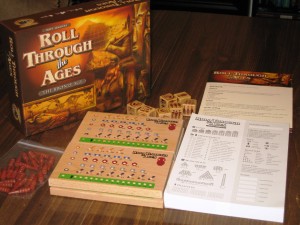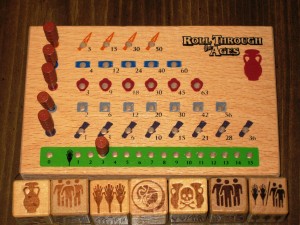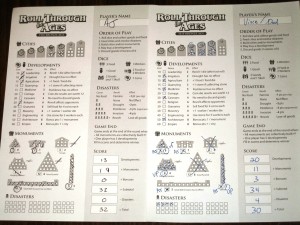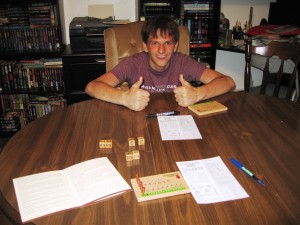I was never a fan of dice games, especially Yahtzee. I think I must have left dice in my pocket one too many times as a kid…to the point where the little buggers got tired of the spin cycle. Maybe they came up with their version of the twilight bark and alerted their brethren to screw me over any time I happened to need them.
Roll Through the Ages: The Bronze Age, is a semi-light dice rolling game that keeps with the “Civilization” theme. Those who have played either the video game or the board game, “Civilization” will recognize some of the monuments and concepts, even if the gameplay mechanics are executed a little differently. Players will be tasked with building up their civilizations in an effort to score the most points by the end of the game.
Components
Dice – These aren’t your typical dice. Rather than dots that represent the numbers one through six, there are pictures that represent various things. You’ll see people who represent builders, wheat which represents food, pottery which represents goods, coin which represents…well…coin, and skulls which represent disasters.
Player Board & Pegs – There are four wooden player boards (one is given to each player) and pegs, both of which help players keep track of how their civilization is currently faring. Players will be keeping track of their food and goods, moving the pegs appropriately as they gain, spend, or lose those resources. There is one row for food and five rows for goods.
Score Sheets – If the player board is a representation of a civilization’s current status, the scoresheet could represent how far it has progressed. The scoresheet will be used throughout the game as players buy developments, build monuments, build cities, and experience disasters. The scoresheet also serves as a guide to remind players what the pictures on the dice mean, as well as allow player to tally points for end game scoring.
Setup & Gameplay
Each player receives a player board, six pegs, a scoresheet, and something to write with. Each peg goes on the zero slot, with the exception of food…each player starts with three food. A start player is determined randomly, and marks a star on their scoresheet to remind players who the start player was for end game purposes. If you are playing a two or three player game, you’ll need to cross off the appropriate monuments on your scoresheet, as they won’t be used for balance purposes.
On a player’s turn, they receive the number of dice as they have cities. Players begin the game with three cities, ergo they will initially be able to roll three dice. A turn consists of the following:
1. Roll Dice & Collect Resources:
The current player will roll the dice, and move aside any skulls that come up. They can re-roll twice, but MUST move skulls aside should they roll them. After two (optional) re-rolls, that player must keep the results. That player will then move their pegs on their player board appropriately to show that they’ve gained resources.
The amount of food you collect, should you roll food, is equal to the number of wheat symbols on the dice. You’d simply move the peg to the right the appropriate number of slots.
The amount of goods you collect is done the same way, one good per symbol shown on the dice. However, rather than move the peg on one good over that many spaces, you move one peg to the right one space, then move on to the next good, move that peg over one space, and so on. Rolling three goods for example would net you one wood, one stone, and one pottery.
Coin is simply noted for this turn only, which will count towards a player’s ability to build developments…more on that later. Coins symbols represent seven coin.
Disasters occur when skulls are rolled. You’ll resolve those in the next step…
2. Feed Cities & Resolve Disasters:
Each city you have requires one food to feed. Move your food peg appropriately. Not being able to feed some or all of your cities counts as a disaster and you’d “X” the number of appropriate boxes under the disaster column of the scoresheet, one box per one city unfed.
Skull rolls represent disasters. However, you only mark “X’s” under your score sheet’s disaster column when you lose points as the result of a disaster. Some developments negate particular disasters, so not all skull rolls will cost you points. Each box is worth “-1” during end game scoring. If a disaster calls for you to lose three points, you’d mark off three disaster boxes.
3. Build Cities or Monuments:
Take a look at how many “people” icons you rolled. You can check off that many boxes under any monument you choose, or mark off boxes on the next city. If you completely mark off all of the boxes on a city or monument, you have “built it”.
If you are the first player to build a particular monument, you score the highest point value shown. Otherwise, you’d score whatever point value was remaining. (All players will cross off point values as they, or other players, build monuments.)
Remember, if you build a city, you can roll more dice on following turns, but your food requirement will go up!
4. Buy a Development:
You may have been wondering what those little numbers under the good slots mean on your player board. That number is the TOTAL VALUE of the goods in your possession, or what they are worth in coin. This total value is then used to purchase developments. When you are ready to buy a development, pick one or multiple goods and move their pegs to zero. Add any coin you may have earned in your dice rolls as well. (1 coin symbol = 7 coin)
There is no change and you must spend ALL of one good when using it to purchase a development. When you buy a development, mark it off on your scoresheet to gain its effects.
5. Discard Goods:
A player can not have more than six goods, so they must discard down to six before the turn is over by moving pegs to the left. The number of goods a player has is not to be confused with their total value / coin value.
The dice are given to the next player until someone has buys their fifth development, or when all players have collectively built at least one of every monument. The scoresheets are then used to tally points. The person with the most points wins!
The Review
The components are few, meaning that setup and clean up is very quick. The players boards and dice are made of wood, giving them a nice heft. There are a lot of scoresheets and to top that off, you can download more here:
Roll Through the Ages – Download Page
On the same website, you can download scoresheets and find rules for a variant that makes the game longer and a little more complex. That variant is called, Roll Through the Ages: The Late Bronze Age.
As I mentioned earlier, I am not a fan of dice games. There is the possibility of rolling all skulls on your first roll, probabilities be damned. People who absolutely hate luck based games may not take to this game fully. What attracted me to the game were the developments, which help to offset bad dice rolls among other things. One game mechanic that I always enjoy, in any game I play, is the ability to “level up” be it via technology, stats, whatever. This game doesn’t offer a huge list of developments, but it serves its purpose for the average play time that it allots. Sometimes, I can’t afford to sit down and spend hours leveling up from sticks and stones to nuclear missiles.
Anthony (16) said that he liked the game and is a lot more fun if you have four players instead of two. From the game that we played, he concentrated on rolling workers and completing monuments. I, on the other hand, rolled a lot of coin and goods, so I was able to quickly buy some developments early on that served me well later in the game. Anthony mentioned in passing that he’d play this game again.
The bottom line? It’s not your average dice game and for that, I recommend it. Potential buyers should still be aware that there is a luck factor involved, even if developments can offset bad rolls. The game plays quickly and is simple enough to where kids can jump right in after a little coaching. All in all, it’s a fun little game to bring out on family game night.
Final Verdict: 7/10
—




